
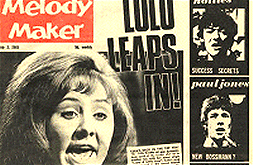

|
 |
|
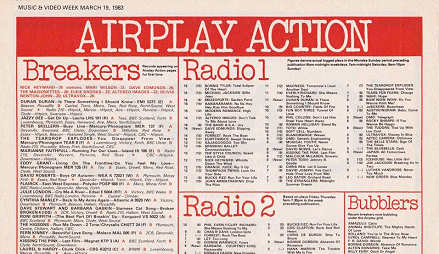 |
There
were quite a number of national popular music publications available during
the 1960's, not all of which produced weekly music charts and of which even
fewer were perceived as carrying 'major' music chart reviews. The NME charts
were generally acknowledged as being the most accurate reflection of record
sales, while Melody Maker was the magazine of choice for most musicians
if for no other reason than it contained many advertisements for job opportunities
within the music industry. Melody Maker was also the place to find out what
group was playing at what venue in any given week. Disc and Record Mirror were also widely read 'public' music papers and there was also the 'trade' paper Record Retailer and the monthly EMI trade publication Record Mail. Many of these appeared under different names at different times as ownership changed or mergers took place. The American 'music trade' magazine 'Billboard' published its first 'record sales' chart on 20th July 1940. It originally had separate charts for different measurements of popularity that included disc jockey airplays, juke box selection and record sales in retail stores. It also published a composite chart compiled by combining all these statistics to provide a Top 100, the forerunner of its current Hot 100 chart. The separate juke box play chart ceased after June 17th 1957 and the separate disc jockey airplay chart after July 28th 1958. The 'Hot 100' title for the composite chart was used after the July 28th 1958 issue and the separate retail sales chart was not published after Monday October 13th 1958. The two other main US music papers were Record World and Cash Box. Specifically female teenage readership was already being targeted by the early 1960s with publications such as Romeo, Marilyn, Roxy, Mirabelle, Boyfriend and Valentine, with Marty (named after pop singer Marty Wilde) joining them in 1960. Boyfriend was very much oriented towards pop music and 'Beatlemania', producing several 'special' supplements such as 1963's 'Big New Beat' featuring a variety of 'close-up and personal' images of The Beatles taken by photographer Fiona Adams, one of which was used for the 'Twist and Shout' EP cover in July 1963. The second edition of 'Big Beat' issued in autumn 1963 featured other artists such as Cliff Richard, Elvis Presley and 'up and coming' acts such as The Rolling Stones, The Searchers and Freddie and The Dreamers. Two new publications entered the market in 1964, both launched during January: DC Thompson's 'Jackie' (as an alternative to Boyfriend) and Fleetway's 'Fabulous' which focussed more on 'Merseybeat' and The Beatles. By the late Sixties 'Jackie' had a circulation of about 500,000. |
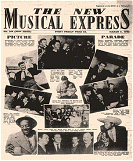 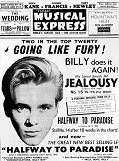 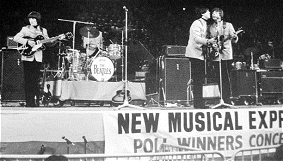 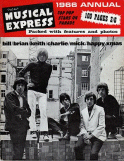 |
Accordion Times Musical Express New Musical Express Accordion Times* - 4th October 1946 to 30th January 1948 Continued as Musical Express - 6th February 1948 to 22nd February 1952 7th March 1952 - Bought out and re-launched as New Musical Express 1st January 1960 to 26th February 1960 - Fridays - Top 30 listing In terms of circulation during its peak years,1964 to 1966, NME was selling around 300,000 copies a week, more than all the other music papers combined *'Accordion Times and Modern Musician' apparently resurfaced as a different publication |
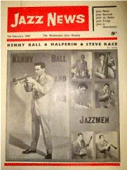 |
Jazz News Jazz News and Review November 1956 to 24th October 1963 7th November 1963 - Continued as Jazz News and Review until December 1963 when it was discontinued. Published weekly in the UK, it covered both the British and international jazz scenes. |
||
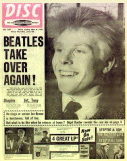 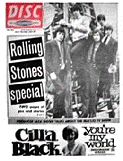 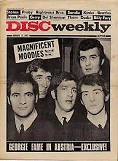 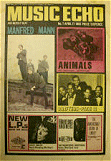 .gif) |
Disc Disc Weekly Disc and Music Echo In 1959 it was Disc's editor Gerald Marks who introduced the practice of presenting a silver disc for sales of 250,000 units and a gold disc to records that sold over one million units Disc - 1st February 1958 to 28th November 1964 Continued as Disc Weekly - 5th December 1964 to 16th April 1966 when it was incorporated with Music Echo Continued as Disc and Music Echo - 23rd April 1966 to 30th August 1975 when it was incorporated with the Record Mirror |
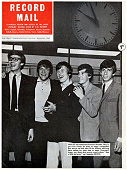 |
Record Mail A monthly EMI 'house' publicity paper featuring their own recording artists and releases, aimed at trade outlets and first published in January 1958 Each month promised a full list of all the new His Master's Voice, Columbia, Parlophone and MGM pop records and contained information about new artists and recordings. |
||
.jpg) |
Melody Maker Founded and first issued in January 1926 by Lawrence Wright, it was originally a monthly publication aimed at jazz fans and musicians, becoming a weekly within a year and 'the world's oldest music weekly'. In 1999 it was relaunched as a glossy magazine, continuing until 20th December 2000 when it was incorporated into its sister paper, and long-time rival, the New Musical Express |
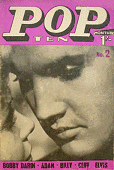 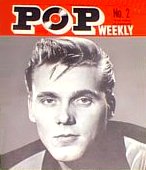 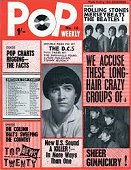 |
Pop 10 Monthly Pop Weekly Pop Shop and Teen Beat February 1962 - First issue of Pop Ten Monthly 1st September 1962 - Re-launched as Pop Weekly Continued to12th February 1966 when it was incorporated with the now-defunct Pop Shop and Teen Beat monthly |
 |
The Record Mirror The Record and Show Mirror The New Record Mirror 17th June 1954 to 15th August 1959 29th August 1959 - Continued as The Record and Show Mirror 18th March 1961 - Continued as The New Record Mirror 16th November 1963 - Continued as Record Mirror - to 6th April 1991 when it was discontinued |
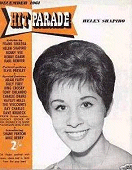 |
Hit Parade HP was a monthly magazine dating from the Fifties and therefore did not publish a weekly best selling record chart. It specialised in publishing in-depth interviews and features about the leading acts of the day |
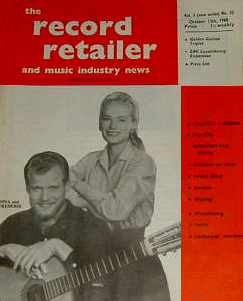 |
Record Retailer Record Retailer and Music Industry News Record and Tape Retailer Music Week Music and Video Week 25th August 1959 - Record Retailer is founded by the Gramophone Record Retailers Association as a monthly trade newspaper for labels and dealers. Roy Parker was managing director and editor. 10th March 1960 - Renamed 'Record Retailer and Music Industry News' 10th March 1960 to 29th June 1967 - published Thursdays - Top 50 listing 5th July 1967 to 30th July 1969 - published Wednesdays - Top 50 listing 5th October 1967 - Reverts to its original title 'Record Retailer' 9th August 1969 to 26th December 1970 - published Saturdays - Top 50 listing 9th January 1971 - Renamed 'Record and Tape Retailer' 18th March 1972 - Re-launched as 'Music Week' 17th January 1981 - Renamed 'Music and Video Week' 3rd September 1983 - Name changes back to Music Week Since April 1991 - Music Week has incorporated the Record Mirror |
.gif) |
Mersey
Beat (The
Mersey Beat Story by Bill Harry) Music Echo and Mersey Beat Mersey Beat, an important and iconic music newspaper of the Sixties, was founded by Bill Harry as an approximately bi-weekly regional publication on Merseyside, its first edition appearing on Thursday 6th July 1961 and selling out all 5,000 copies printed. In 1963 it began compiling a Top 20 chart based on around 10 local stores and became weekly on Thursday 23rd April 1964. Following an investment in September 1964 by Brian Epstein, it expanded its chart and sample size to become the first publication to announce a Top 100 on Thursday 3rd December 1964. Its popularity was such that it eventually became a national publication and on Saturday 6th March 1965 the paper was rebranded Music Echo and Mersey Beat by Bill Harry, later becoming simply the Music Echo, and was eventually incorporated into Disc becoming the Disc and Music Echo on 23rd April 1966 |
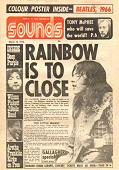 |
Sounds A long-term UK weekly pop/rock music newspaper, published from 10th October 1970 – 6th April 1991. It was produced by Spotlight Publications (part of Morgan Grampian), which was set up by Jack Hutton and Peter Wilkinson, who left Melody Maker to start their own company Sounds was a paper leaning more towards progressive rock and was described by Hutton, to those he was attempting to recruit from his former employment, as "a left wing Melody Maker". The publication was intended to be a weekly rival to titles such as Melody Maker and New Musical Express (NME). It was popularly known for giving away free posters in the centre of the paper (initially black and white, but colour from late 1971) and later for its coverage of heavy metal, especially in its late 1970s-early 1980s heyday. |
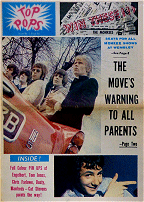 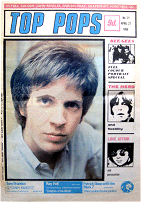 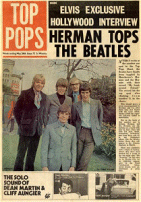 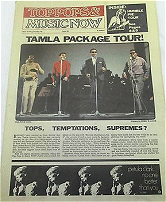 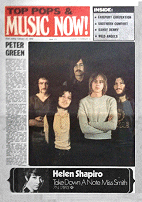 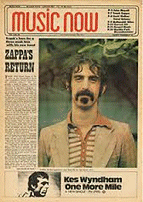 |
Top Pops Top Pops and Music Now Music Now This publication was founded by Woodrow Wyatt in May 1967, initially as a three-weekly newspaper with colour content. Its first editor was Marcus Davidson, previously editor of the Birmingham Planet, one of a series of web-offset colour newspapers that had recently expired. Peter Wilson-Ferrill advises "The first office of Top Pops was above the offices of the weekly Banbury Guardian, also then owned by Wyatt. Davidson took me with him to Banbury as his assistant. I had been hired just four weeks previously as a Sub/reporter on the Birmingham Planet. Neither Davidson nor I knew anything about pop music!". When Davidson left to work at BBC2 after 3 or 4 issues, Peter acted as editor for the next few issues until Colin Bostock-Smith was recruited from the Evening Standard. Peter also left soon afterwards for a career in daily journalism. Top Pops began compiling a chart based on a telephone sample of 12 W.H. Smith & Son stores in May 1968. The paper and its music charts, with a circulation of about 78,000, became fortnightly in November 1967 and weekly in June 1968. It was re-branded 'Top Pops and Music Now' on Saturday 20th September 1969, becoming simply 'Music Now' on 21st March 1970 until its demise in May 1971 |
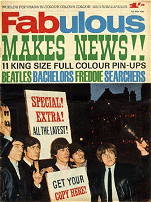 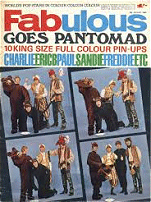 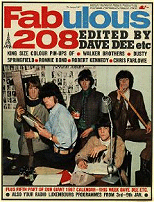 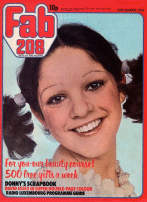 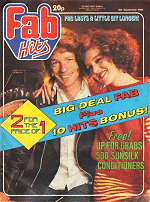 |
Fabulous Fabulous 208 Fab 208 Fab Hits Fabulous pop paper / magazine was launched by Fleetway on 18th January 1964 and was one of the top selling music magazines of the 60s and 70s, running for nearly 900 issues. Its name was changed to Fabulous 208 on 4th June 1966 when it became the 'official' paper of Radio Luxembourg after a deal to publish Luxembourg's programme listings and other items before it became just 'Fab 208' in the 1970s. Its large 13½ x 10½ pages consisted of full colour shots of pop artists and groups, taken by top photographers, including David Steen and Robert Whitaker, which could be used as wall posters. Predominantly concentrating on 'Merseymania' at the outset, it contained at least one pin-up of The Beatles in every issue for two years and some issues, such as 15th February 1964, were almost totally devoted to the group. Fabulous also had 'guest' editors such as Dave Dee & Co (Dave Dee provided an 'advice' column!) and The Kinks. After a brief final few publications renamed 'Fab Hits', its last issue was published on 27th September 1980 |
||
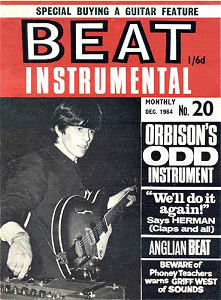 |
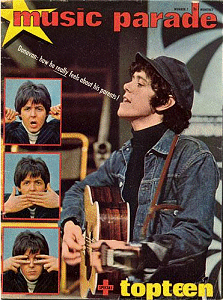 |
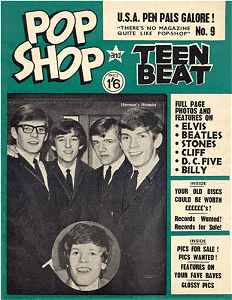 |
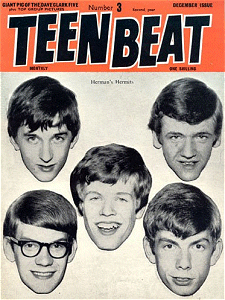 |
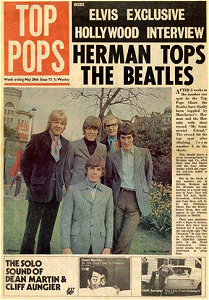 |
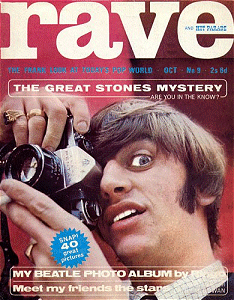 |
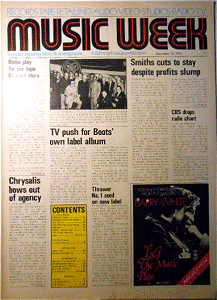 |
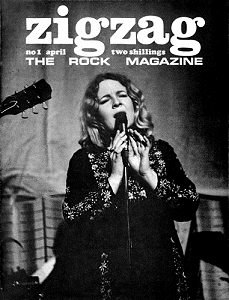 |
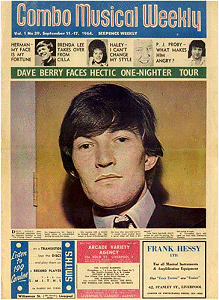 |
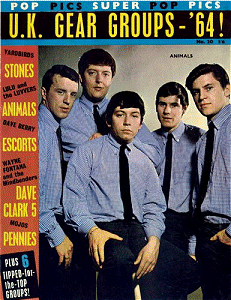 |
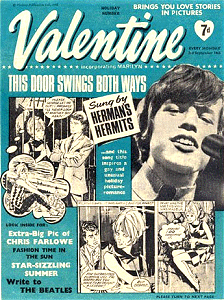 |
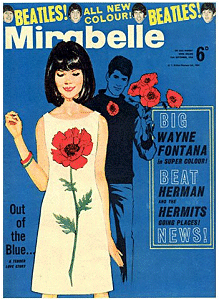 |
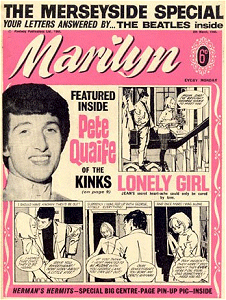 |
 |
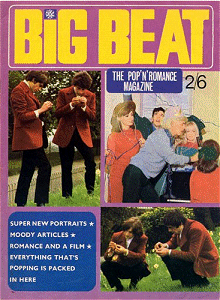 |
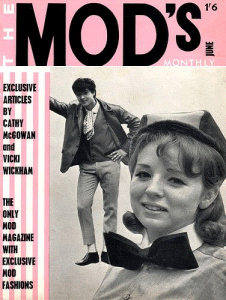 |
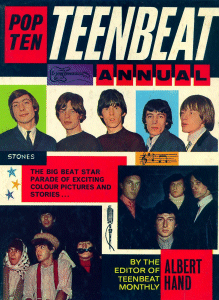 |
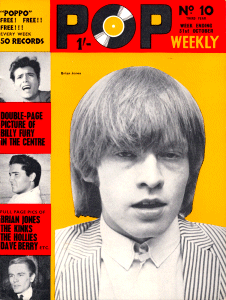 |
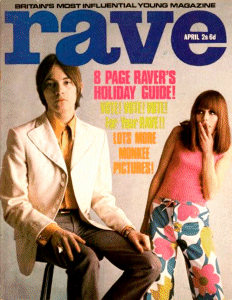 |
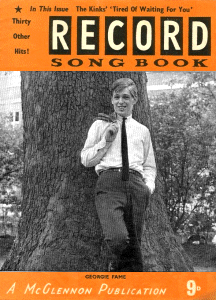 |
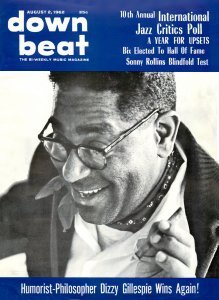 |
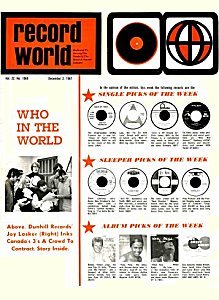 |
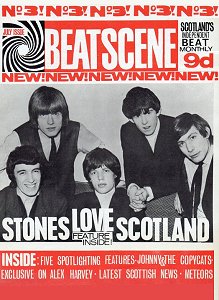 |
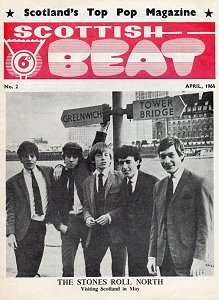 |
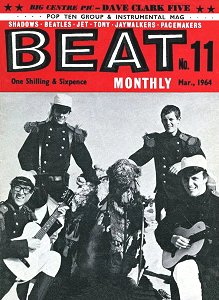 |
 |
 |
 |
 |
 |
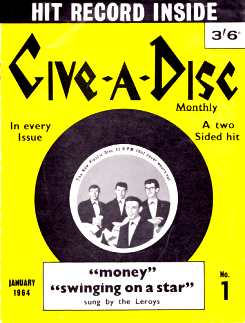 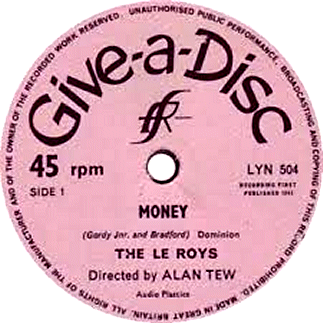 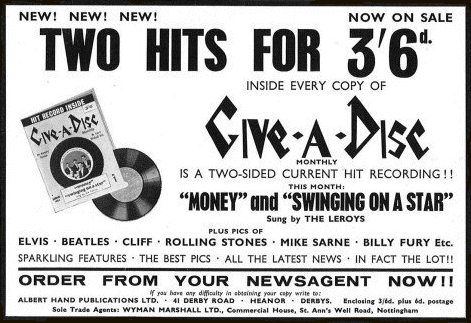 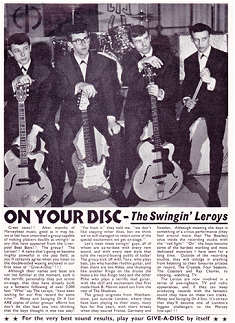 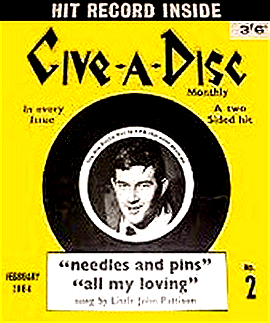 |
Pop Magazine and Music
Paper Chart Listing Timeline
|
1959
1963 |
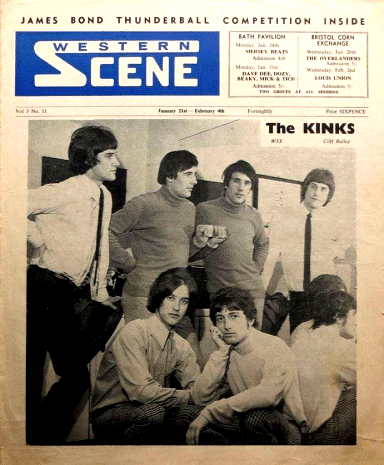 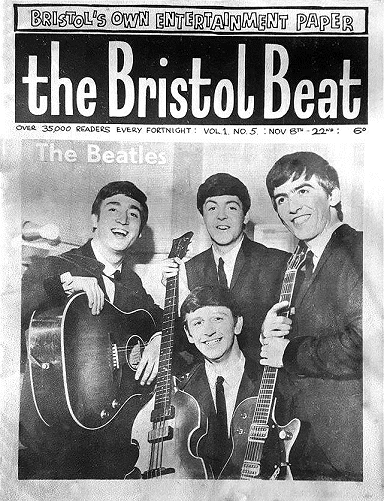 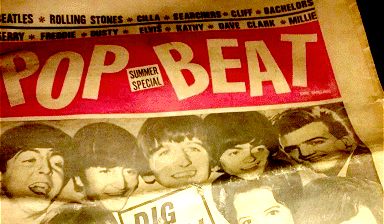 |
|
|
All
Original Material Copyright SixtiesCity
Other individual owner copyrights may apply to Photographic Images |